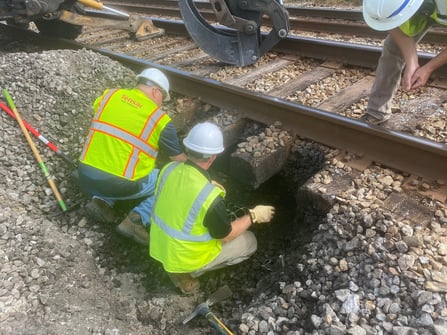Rail Infrastructure Resilience Starts With A Geogrid-Stabilized Track
by Don Herbert, on October 25, 2022
Imagine hauling the Great Pyramid of Giza once a month across the same track over 32 years. That is how much weight has crossed a Tensar geogrid-stabilized segment of railbed in Mobile Bay, Alabama, during that time. To translate that into today's terms, that's 40-foot intermodal containers packed to capacity, stacked four-high, lined up end-to-end and transported back and forth to the tune of two billion gross tons of rail traffic over three decades.
The Mobile Bay segment is one of the most intensively used stretches of rail that carries heavy coal freight trains between Siebert Yard to the McDuffie Bulk terminal over a tunneled section of I-10. During the late 1980s, the heavy usage resulted in monthly maintenance and complete resurfacing every six months.
In 1989, the 1000-ft segment was reengineered using multiple layers of Tensar geogrid. When appropriately installed, geogrids provide aggregate stabilization and filtration. For the Mobile Bay project, the installation consisted of one layer of geogrid beneath the sub-ballast and another between the ballast and sub-ballast. Maintenance intervals were immediately extended by a factor of 3 to 4. Over time, they improved further until this section of track was at the same rate as the rest of the port facility.
 That durability extends beyond normal wear and tear. Mobile Bay is particularly vulnerable to ever-increasing adverse weather events, and that segment has been flooded regularly. In 2005, Hurricane Katrina covered it under 12 feet of floodwater.
That durability extends beyond normal wear and tear. Mobile Bay is particularly vulnerable to ever-increasing adverse weather events, and that segment has been flooded regularly. In 2005, Hurricane Katrina covered it under 12 feet of floodwater.
In 2020, samples of the geogrid were exhumed from a 1000-foot section and tested after 32 years of service. Most stabilization properties were still in keeping with 1989 specifications. The index properties of the exhumed geogrids were compared to the quality assurance specifications outlined in the 1988 geogrid material data sheets. The geogrid samples were approximately 45% more rigid (i.e., increased stiffness) than when the product was originally installed.
Rail Resilience: Return on Investment
The substantial reduction in maintenance and material costs along with the proven performance benefits of geogrid-stabilized layers found in the Mobile Bay installation confirmed that geogrid can be a key element to achieve both rail infrastructure resilience and environmental efficiency.
Mechanical stabilization with geogrid offers multiple potential sources of value:
- Reduced maintenance costs due to the extension of resurfacing intervals
- Reduced construction cost for new track sections
- Improved sustainability and reduced carbon footprint due to lower material quantities and fewer equipment mobilizations
- More durable and resilient structures to better withstand extreme events
Get a predictable, cost-effective solution for the stabilization of ballast and sub-ballast layers. Learn more about our engineered solutions for the rail market.



